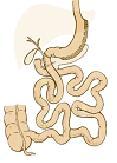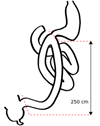Duodenal switch DS / Single anastomosis Duodeno-Ileal with Sleeve gastrectomy SADI-S
The Modified BPD/DS combines restrictive and malabsorptive elements to achieve and maintain the best-reported long-term percentage of excess weight loss among modern weight-loss surgery procedures. This is performed laparoscopically giving all the benefits of laparoscopic surgery.


Read what the The National Institute for Health and Care Excellence (NICE) has said for this procedure Click Here
LINKS TO YOUTUBE FOR THE SURGERIES
Duodenal Switch /SADI
- Duodenal Switch: https://www.youtube.com/watch?v=6f-QKPcMPzg&t=9s
- Duodenal Switch and Fundoplication for GORD and bile reflux gastritis: https://www.youtube.com/watch?v=drOOXjRAXC0&t=171s
- Gastric bypass with GG fistula to SADI for weight gain : https://www.youtube.com/watch?v=9wmwc7oQQwk
- Conversion of Gastric bypass to Single Anastomosis Duodenal Switch SADI: https://www.youtube.com/watch?v=BsjZM8fLHn0
1. The Restrictive Component (Sleeve Gastrectomy)
This stage of the operation involves removing ¾ to 4/5 of Stomach along the greater curve of the stomach leaving the stomach in the form of a narrow tube. The pylorus is intact and therefore this effectively restricts the stomach capacity without affecting its function. Also it effectively removes the part of the stomach that produces Ghrelin, the appetite producing hormone. For many people with BMI at a level where one considers restrictive procedure this could be used instead of the gastric band. It works well without having a foreign body and the results are comparable to gastric bypass at 1 year as our data suggests, but the stomach starts to stretch after a couple of years when one may have to consider to repeat the same procedure or convert to a bypass or a DS.
2. The Malabsorptive Component (distal bypass) – Actual DS
Actual DS (2nd stage DS)
The small bowel is divided near its middle (about 300cm from the ileo-caecal valve) and the distal divided small bowel (alimentary limb) is joined to the proximal divided duodenum (just beyond the pylorus, stomach outlet). The proximal part of the divided small bowel (biliary limb) is joined to the distal bowel about 100 cm from the ileo-caecal valve (junction of the small and large bowel). Thus the malabsorptive component of the DS procedure rearranges the small intestine to separate the flow of food from the flow of bile and pancreatic juices for a long distance. This inhibits the absorption of calories and some nutrients. Further down the digestive tract, these divided intestinal paths are rejoined; food and digestive juices begin to mix, and limited fat absorption occurs in the common tract (100cm) as the food continues on its path towards the large intestine.
SADI-S
The proximal Duodenum of the divided duodenum is anastomosed (joining) to the loop Ileum about 250-300cm from the ileo-caecal junction, without joining the ileum to ileum and disconnecting the ileum (BP limb) from the Alimentary limb at the DI anastomosis. This can be used instead of DS if you don’t have GORD
How DS works / SADI-S works
Sugars, protein and nutrients are absorbed to a limited degree in the food tract. Fat absorption occurs only in the common tract. Therefore, the shorter the common tract, the less fat absorption can occur.
Advantages
The DS procedure keeps the pyloric valve intact. This eliminates the possibility of dumping syndrome, marginal ulcers, stomal strictures and blockages, all of which can occur after other gastric bypass procedures. The preservation of the pylorus means the food is allowed in very small quantities into the small bowel from the stomach and that too in a softer consistency. As a result the DS procedure enables more normal absorption of many nutrients including protein, calcium iron and vitamin B12 than is seen after gastric bypass procedures. The stomach will eventually (after 12 – 18 months or so) expand to hold a small- to near-normal-sized meal, with weight loss being maintained by the malabsorption component of the procedure.
The beauty of this operation is that the operation could be performed in 2 stages to reduce the risks of surgery, especially in patients with very high BMI (Super obese) or with risk factors. First, Sleeve gastrectomy is performed; this may reduce the excess weight by about 30-50%. The next stage of the operation (malabsorption) is performed 12-18 months later; patient is much fitter at this stage. Shorter operation times and low leak rates help reduce the risks to a minimum.
Possible Complications of DS surgery
IMMEDIATE:
The main risk from these surgeries is the leak from the join or staple line. This causes peritonitis which requires further surgery and intensive management.
LATE:
In general, a shorter common tract means that patients might experience more of the side effects that can affect all distal bypass patients (e.g. smelly gas, diarrhoea, vitamin, iron & calcium deficiencies, protein calorie malnutrition. The patients have to understand the operation well to adjust their life style especially the diet. You require high doses of Vitamins, minerals and Protein (90-120gm rather than 60gm). You require about 5,000units Vitamin A, 5,000units of Vitamin D, Iron supplement and multivitamins (for minerals and Vitamin E and K). you should focus more on vegetables, pulses and fish/chicken/meat. you require protein supplement to boost the protein intake.
1. Problem with foul gas and loose bowels
Because of the reduced absorption of nutrients and fats after a distal gastric bypass, patients can experience loose stools and bad-smelling flatulence but this problem generally improves and resolves itself within 6 months after surgery. This doesn’t just affect duodenal switch patients — it can affect anyone who undergoes a distal bypass.
There are several remedies that you can use to minimize the problem: 1. Avoid high-fat foods. This is probably the most effective way to combat the problem. 2. Taking Chewable Bismuth Subgallate tablets/Activated charcoal tablets. Activated Charcoal may absorb other medicines
2. Dumping Syndrome
Dumping Syndrome is a condition that can cause unpleasant symptoms such as diarrhoea, nausea, light-headedness, cold sweats, weakness, tiredness, fast heart rate and stomach cramping. This occurs in the gastric bypass patients when foods pass too quickly from the stomach into the small intestine. Dumping Syndrome can be caused by eating foods high in sugar or fat, or by drinking liquids and solids together after gastric bypass surgery. Regardless of the surgery, foods high in sugar and fat content are discouraged due to the high calorie content. Dumping syndrome is much less in DS and SADI-S because of the retention of the pylorus and the duodenum.
3. Nausea /Vomiting/Pain
This is often caused by eating too much or too fast. Following surgery, patients will not be able to eat the quantity of food they presently eat. Other causes of nausea and vomiting include ulcers or stricture, as well as drinking liquids with foods, and not chewing or blenderizing foods well enough. Be sure to eat in a slow, calm manner. If vomiting, nausea or pain persist, contact your doctor to rule out ulcers or stricture (narrowing).
3. Hair Loss
Hair loss is a side effect of weight loss surgery. You may not see hair loss initially. Often it takes several months after surgery for hair loss to begin. Hair loss should resolve when weight and nutritional intake stabilizes. Hair loss can occur from a low protein and zinc intake, and a severe decrease in overall nutrition. It is important you eat foods high in protein and take a daily multivitamin/mineral supplement which provides a source of zinc.
4. Constipation
Constipation after gastric bypass surgery and restrictive procedures is common and should be prevented. Decreased intake of food, fibre and fluid along with iron and calcium supplementation can lead to constipation. Your doctor may recommend a stool softener or laxative. 1. Drink plenty of fluid. 2. Exercise regularly. 3. Try baby food prunes or unsweetened prune juice, applesauce or oatmeal.4 Once you start on a regular diet, you can start eating high fibre foods; Chew all fibre-containing foods to a paste consistency. 7. Drink plenty of fluids when increasing fibre in the diet. Take Isphagula Husk twice a day.
5. Lactose Intolerance
Some people may experience intolerance to milk products after some types of weight loss surgery. Symptoms are gas, cramps and diarrhoea. This occurs if the body is not making enough of the enzyme lactase. Lactase is the enzyme needed to digest milk sugar or lactose. Some people may become intolerant to some but not all milk products. Should lactose intolerance occur, soya products or products that are lactose free or low lactose can be used. There are also tablets, which if chewed well can be used before dairy containing meals to improve tolerance to lactose.
6. Food Intolerance
Some common problem foods are red meat, bread, pasta, rice and the membrane of citrus fruits. Toasted bread is better tolerated than untoasted bread. Red meat should be tried last. Red meats are high in muscle fibre, which is difficult to separate even with a great deal of chewing. Always be very careful and chew well.
7. Loss of Muscle Mass
Loss of muscle mass can occur after weight loss surgery, but it is preventable. It is very important to exercise after surgery. After weight loss surgery, the body is trying to combat starvation and will consume unused muscle for energy and you will lose muscle mass and strength. It is important to start walking as soon as you go home. Always follow your physician’s advice on when to exercise
DIET You will need to take daily multivitamins, vitamin D, extra calcium and iron. Extra protein is sometimes recommended early on, just after surgery. Your doctor can check your bloods. If you follow these simple guidelines, mal-nourishment is very unlikely to occur. It is generally recommended that you consume around 90 rather than 60 grams of protein each day. Common sources of protein are lean meats, poultry, fish, eggs, cheeses, yoghurt, legumes and nuts. You may need supplemental protein liquids, powders etc.
What do we do if there are severe nutritional problems?
If the nutritional problems become too much and too difficult to cope with, the common limb where the digestion occurs, is increased in length by about 150-200cm by dividing the alimentary limb at the Ileo-ileal anastomosis and moving it up the biliary limb and joining to it at that point.
What if there is insufficient weight loss?
A. If the amount one can eat is less –
The malabsorption is increased by reducing the common limb where the digestion occurs, to 75cm by disconnecting the ileo-ileal anastomosis and moving the biliary limb down the common limb and joining to it.
B. If the amount one can eat is too much:
Re-Sleeve can be done by trimming the remaining gastric ‘sleeve’ to a narrow tube, so that one can eat much less food. This way there is reduced calories.
Warning! : Contains live recorded footage of Weight loss surgeries. May not be suitable for all viewers.
Warning! : Contains live recorded footage of Weight loss surgeries. May not be suitable for all viewers.